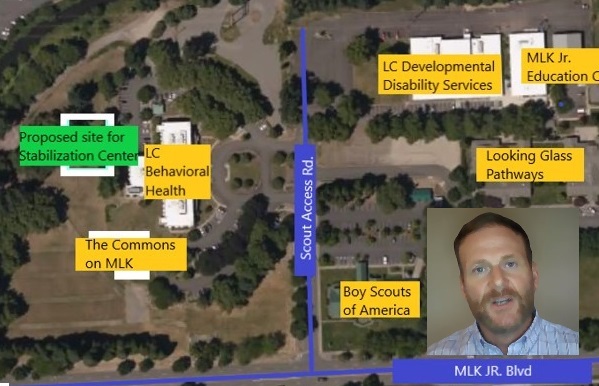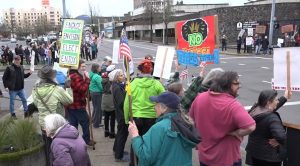Lane County: Stabilization center will serve 8,200 each year
7 min read
Lane County’s next behavioral health facility is scheduled to open in 2025. It is sorely needed, according to Public Information Officer Jason Davis.
[00:00:09] Jason Davis (Lane County Health and Human Services): We are not only seeing an increase with the visual representation of homelessness and that tie to mental health, we’re also seeing an increase in overall crisis situations happening—the incidence of crisis situations in Lane County. We’re seeing increases in addiction. Obviously, you’ve seen the news lately with the increase in fentanyl supply in our community, homelessness, and emergency services are taxed and overwhelmed.
[00:00:34] Not only that, but we have a severe, severe gap in our mental health continuum of care that we don’t have an expanded capacity for someone within Lane County, regardless of who they are.
[00:00:45] Whether it’s someone who has private insurance, has a 9-to-5 job, but is in the middle of a mental health crisis and can’t get ahold of their provider; someone who is unhoused and in the midst of a mental health crisis and is interacting with law enforcement; or someone else; whatever that situation is, we just don’t have adequate capacity here in Lane County for those folks who need that stabilization service.
[00:01:08] And the reason we don’t call it necessarily just a crisis center is we wanted to focus on the outcome. So crisis is why you go in. Stabilization is what you achieve when you walk out of this center, and that’s what we’re aiming at. So that’s why we call it the ‘Stabilization and Crisis Center.’ We really wanted to lead with that outcome-based title.
[00:01:27] So what will a stabilization center do? So what it will do is that it will reduce incarceration and emergency room visits. PeaceHealth has served as a de facto crisis center in our community, thankfully so, because those folks have nowhere to go otherwise. But they are taxed, it’s overwhelming to their system, and honestly, it’s not where their forte should be.
[00:01:45] We’re able to treat underlying needs with this. So it’s not just that quick stabilization and then back on the street. It’s actually looking at the individual, where they’re at, and what they need to take that next step. It’s about improvement for the individual. It’s about improvement for the community, and it’s about improving that state that the individual’s in.
[00:02:03] We’re able to coordinate existing resources. I can’t tell you how much I hear two things. One is, ‘We don’t have capacity,’ and two is, ‘There are services that go unused.’ And so those seem to be at odds with each other, but they’re actually not. Because what we see is there are some services that are overtaxed and there are some services that are underutilized.
[00:02:23] What the stabilization center will hopefully do is connect those existing resources for greater efficiency so that we’re fully using everything that’s within our community. We’re actually very fortunate in Lane County with the service providers that we have available to us. There are thousands of nonprofits focused specifically on how to make Lane County a better place to live for everyone.
[00:02:44] And if we start to be able to realize the potential of all those different service providers through a coordinated system that is looking specifically on mental health, then we’ll see some upstream improvement, overall systems utilization.
[00:02:55] We’ll see increased safety in public spaces. That’s something that I hear a lot too, is, ‘I don’t even go downtown anymore.’ ‘I don’t go to this neighborhood anymore.’ And what the stabilization center will be able to do is help people that we see today having that crisis in a public space with no help.
[00:03:13] We do have help in the way of mobile crisis in our county, but as you all know, they are taxed. Sometimes the wait time for an individual can be exceedingly long, and it’s not because our crisis services aren’t fantastic and good at what they do, it’s just that there’s too much demand.
[00:03:27] So being able to have a place for those mobile crisis folks to take someone, for law enforcement to take someone, for someone to be able to walk through the door before this crisis starts to happen—then we start to see a more efficient and better utilization of those mobile crisis services, of law enforcement of our jails, of our emergency rooms, etc. And we see an increased sense of safety in our public areas.
[00:03:50] So nuts and bolts, a little bit: This is going to be a 24-7 facility, open seven days a week, 24 hours a day, obviously 365 days a year. Someone will always be there at the front desk to either take walk-ins—that’ll be a component of the facility—but then also a separate sally port for those referrals or escorts from law enforcement or mobile crisis.
[00:04:11] There’ll be immediate triage as soon as someone comes in looking at, you know: What does this individual need? How can we help them? What services do we need to afford to them?
[00:04:19] And then looking at the next steps. So some people, all they might need is just a place to decompress, to be able to sit in a recliner and not have to worry about all the outward stressors that they were experiencing when they went into the stabilization center.
[00:04:33] Other folks may need more intensive behavioral health services. So we’ll offer peer support, case management and then obviously the ability to prescribe if someone does need that.
[00:04:43] And then as they exit the facility, this has been a concern wherever we tried to site the facility is: What happens when people walk out through those doors? Do they just go right back into the neighborhood? Are they going to be camping around the facility? What’s going to happen? And the answer to all those is ‘No.’
[00:04:59] And there will be a, what we call a ‘warm handoff,’ so a connection to the next step: looking at what that individual needs, where those services are, and then actually transporting them to those services.
[00:05:10] So siting has been a huge part of our efforts with community engagement. Anytime we looked at a site, there’s been complications, zoning considerations…And we really did have trouble finding that perfect place. And thankfully we have landed at a place that we think will be a good starting step and hopefully a permanent home for the stabilization center on our current Lane County Behavioral Health campus.
[00:05:34] And this actually mirrors sort of a best practice in crisis centers across the country where you have what’s called a campus of connections, where you have multiple services for the individual available all within reach.
[00:05:46] MLK Jr. Boulevard, by virtue of its connection to our interstate and our other highways and other arteries within Eugene and Springfield, does have that sort of hub place for it. And then it’s an easy place for law enforcement, pretty close proximity to the jail. And then also for emergency services as well. And thankfully we’re zoned for clinical use. Check that one off too. So you see all those check marks, it’s hard to argue what’s the benefit of taking advantage of additional or of existing county property as well.
[00:06:17] This conversation’s been going on since 2014 and arguably before that but it really advanced when ARPA funding became available for certain community improvement projects. And that’s where we saw that trajectory in 2020 really start going at a much more rapid pace. … and opening there hopefully by 2025.
[00:06:38] We’ve currently leveraged, like I said, ARPA funding and a few other different pots of money. But we really still looking for that ongoing support from the state and fed.
[00:06:46] And: We’re looking at 42 individuals in total at any one time, 14 of those will be adult respite chairs. And so again, that’s like a recliner. Those will be for those individuals either who are just at the beginning of their stabilization process and then will move into additional behavioral health supports, or individuals who are, that’s the full extent of their stabilization. So a respite chair is certainly one of the lowest acuity interfaces that we’ll have.
[00:07:16] Sixteen adult short-term stabilization beds, where folks can actually spend the night take some time in their stabilization process. And then 12 short-term youth stabilization beds… The annual impact: 8,200 folks will be able to walk in through those doors and receive stabilization, which will take a huge bite out of what we’re seeing happen in the community right now in that lack of services and the spiraling crisis.
[00:07:41] John Q: Speaking with the Northeast Neighbors on May 25:
[00:07:46] Jason Davis (Lane County Health and Human Services): There will be a community-wide survey that’s going to be going out here in about a month. And hopefully you’ll see that pop up both on the news and your inbox and any other way that we can get to you to make sure that we get a lot of feedback from our community in this process.
[00:07:59] Oftentimes we’re asked: ‘What can I do? How can I be a part of this?’ Or: ‘What can I do to help?’ One of the best ways that our community can help and certainly looking forward is to start to socialize the concept of the stabilization center. The more that realize it as a norm within our community, as a place to go, the greater participation we’ll have and the greater the better outcomes we’ll have.
[00:08:22] And then also just continue to lend your thoughts. Several really great ideas have come from some of our community engagement.
[00:08:29] John Q: Lane County hopes to open the Stabilization and Crisis Center in 2025.





